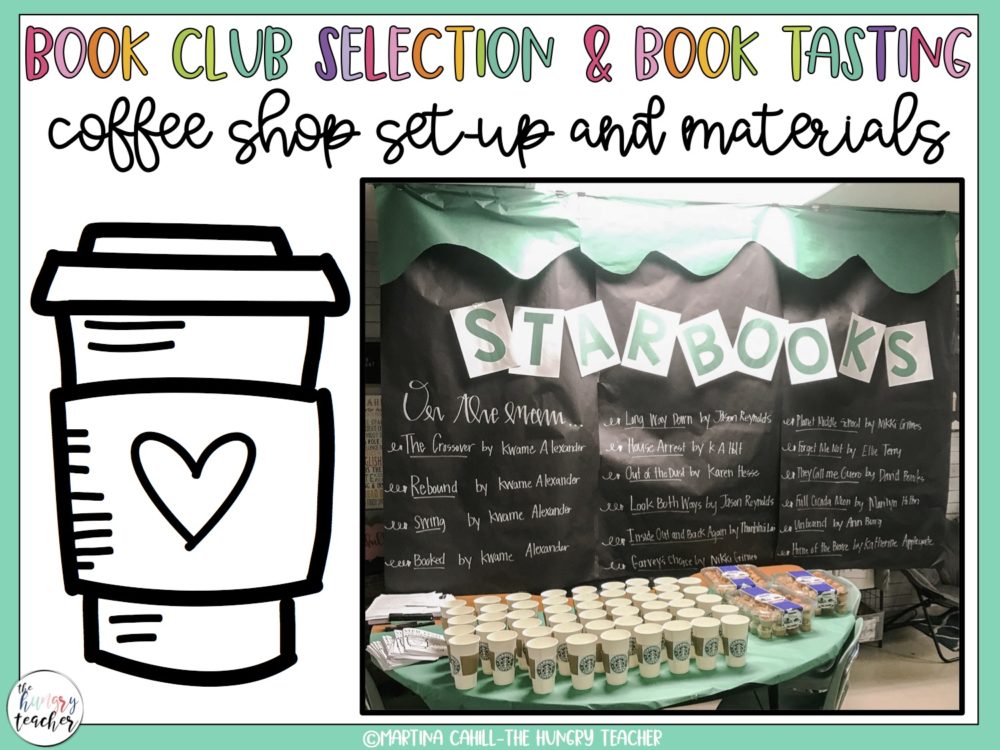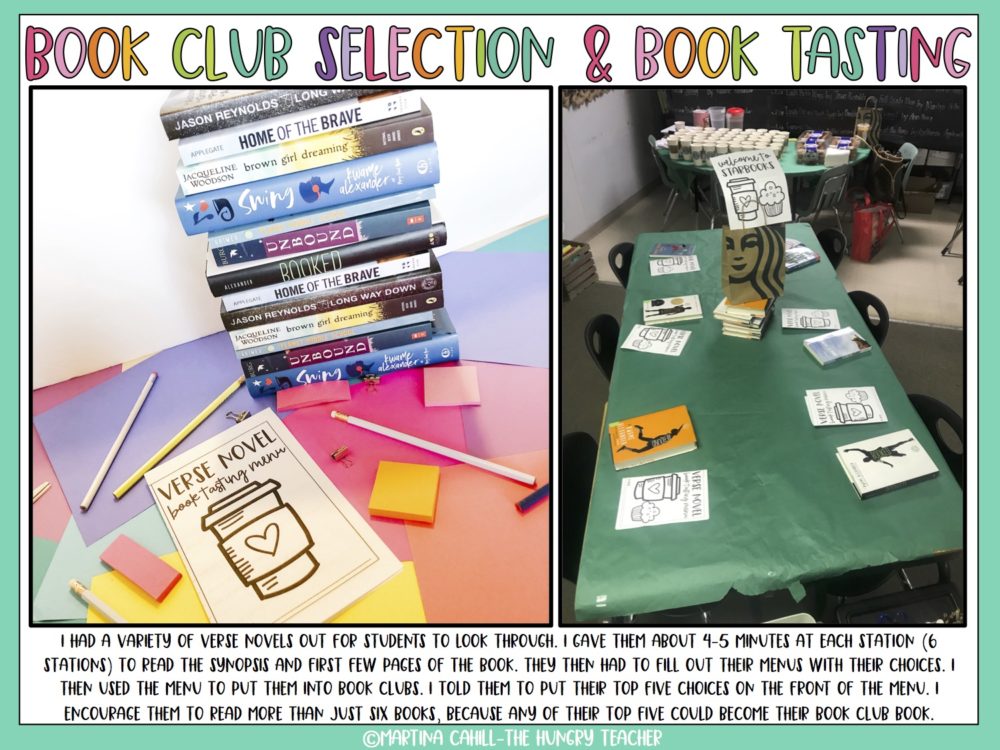hey friend!
I'm Martina.
I provide practical, time-saving strategies that actually work—so you can engage your students, teach effectively, and reclaim your time from the exhausting planning-grading cycle.
Browse Our ELA Resources
Use Poetry and Verse Novels in Middle School
I have dreamed of creating a middle school poetry unit. I knew I wanted lesson plans, tons of reading response examples of poetry analysis, along with a verse novels book club and activities component. I have spent the last month creating this complete middle school poetry reading and writing unit.
NOT JUST POEMS AND POETRY TERMS
I have been teaching poetry to my middle school students for the last three years. During that time, we spent so much of it just learning poetry terms and reading poems. It was like we were spending so much time learning the terms and types of poems, that we didn’t have a lot of time left for true analysis. I knew we should have been digging deeper in poetry and verse writing. My thinking was that we could do so much more with poetry if my students could use verse novels and book clubs. They needed a structure that would make them read and write a ton with those novels.
This thought became the inspiration for my now four-week poetry unit. The gist of what I set out to accomplish was to have strong read aloud verse novel mentor texts that I could do a ton of modeling with. Then students would apply my teaching and mini-lessons to their own book club verse novels. The goal was also for them to read and write as many verse novels as possible. Yet, I didn’t want students to be boxed into book clubs that forced them to slow down their reading.
READING VERSE NOVELS TO TEACH A POETRY UNIT FOCUSED ON ANALYSIS
I think my unit has found the perfect happy medium. Students are reading the same verse novels as some of their classmates so they can collaborate, discuss, and dig deeper into the novels. At the same time, the work done each day/week is open ended enough that students could be reading any verse novel and still be able to do the work.
We start the unit with a couple of days of learning poetry terms, types of poems, and vocabulary to get them going. After that, the bulk of the unit is spent referencing those terms. The students are encouraged to really analyze poems and verse novels using the vocabulary that is front-loaded.
GETTING STUDENTS INTO BOOK CLUBS
I wanted to build the excitement about verse novels and book clubs in general. There had been some Starbooks and/or book tasting ideas floating around social media and I knew I wanted to use it. Book clubs seemed liked the perfect time to implement this idea. I have a blog post all about this resource (the resource is included in the poetry unit as well). Just click here to check it out.
POETRY TERMS, TYPES OF POEMS, AND FIGURATIVE LANGUAGE
Pretty much since I have started creating reading units, I felt that it was best for students to be exposed to the vocabulary first. Simple and quick exposure is my goal. Then that vocabulary is used and referenced throughout the entire unit for analysis. Here is the pace for the unit.
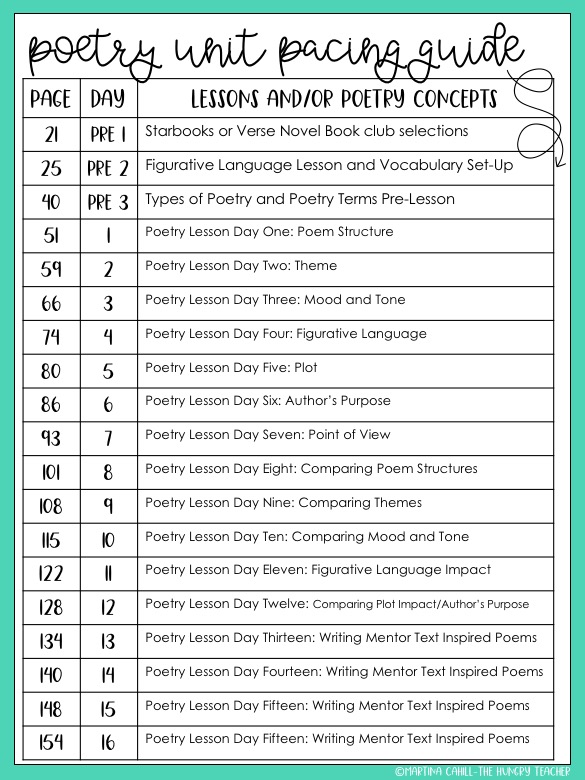
You can see that after one day of the Starbooks cafe, we do two days of front loading vocabulary. As a teacher, I have gone through ebbs and flows with how we take notes. Most of the time we do interactive notebook pages. Other times I really just need them to have the reference. So to save time, we just glue in a reference page. Both options are included for teachers. There are other variations as well.
INTERACTIVE NOTEBOOK PAGES
For this first time, we did do the interactive notebook pages. I felt like they (especially my 7th graders) really needed to internalize and interact with the poetry terms, types of poems, and even some literature terms.
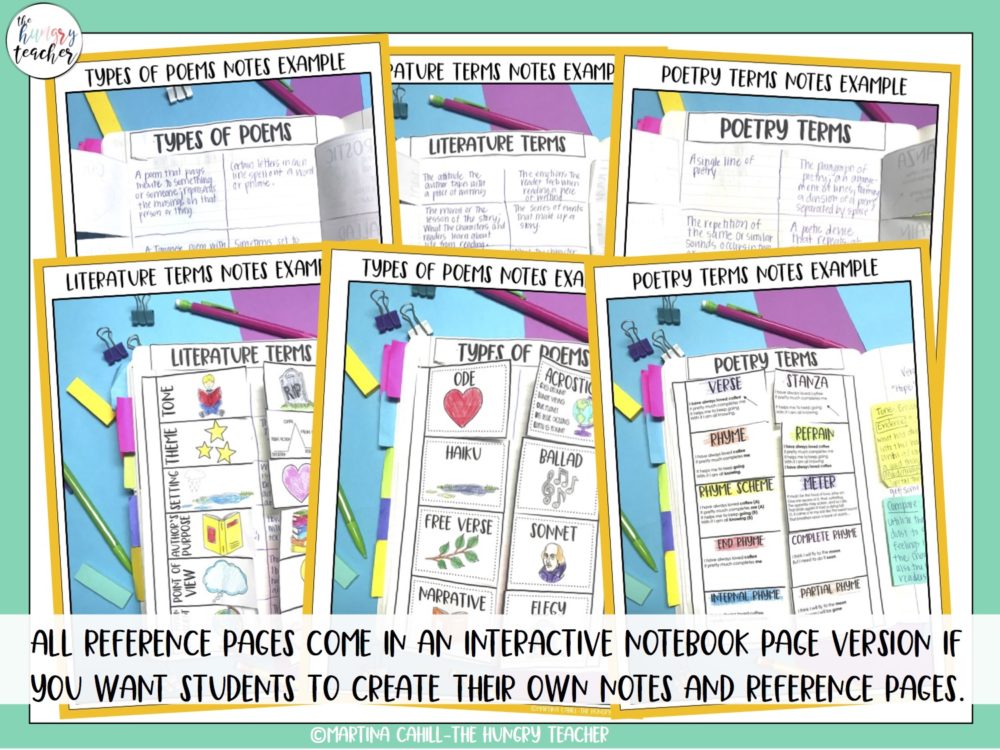
NOTEBOOK REFERENCE PAGES
My 8th graders did take notes on the figurative language, but since I have had them to years, we just glued in the literature terms as a review for them to reference.
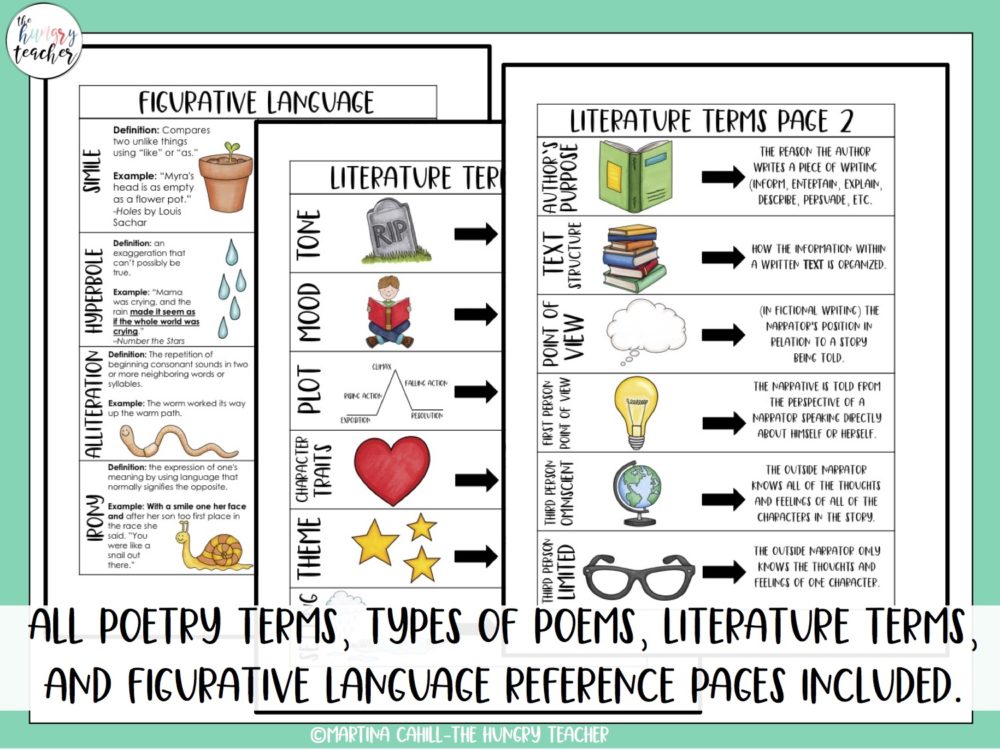
At home, I do have that amazing resource called HP insta ink, but I honestly never get anything done or printed at home. 99% off the time, even if I want to print in color, I print in black and white at school because it’s easier. I know other teachers do the same so everything comes in black and white and color versions.
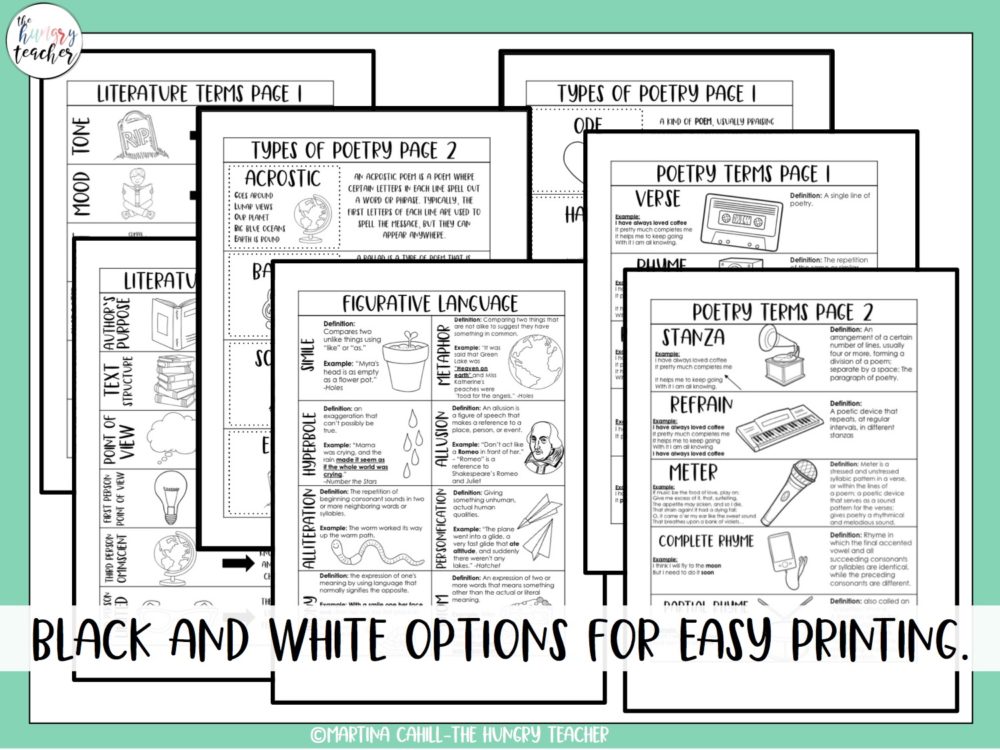
NOTEBOOK REFERENCE PAGES WITH TABS
Lastly, I made note notebook tab reference sheets with all these reference pages and interactive notebook pages. They are very similar to the reference pages, but they have tabs for students to easily access the reference they need. You just cut around the sheet and the tab, and when you glue, you make sure the tab hangs off the paper. They are included in the resource!
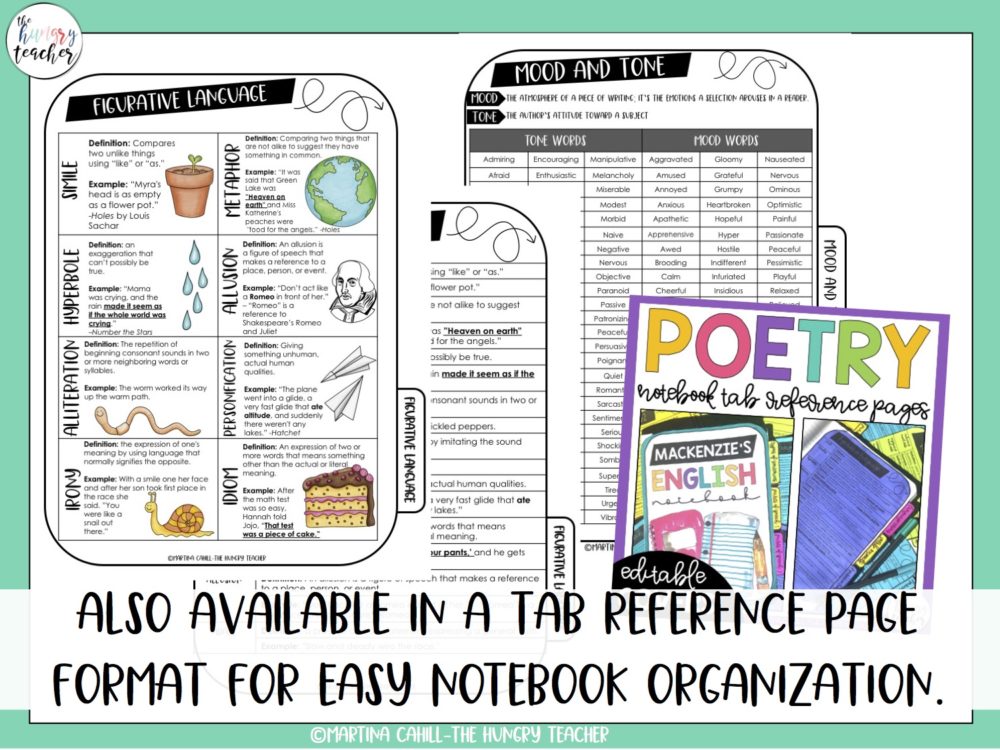
USING MY VERSE NOVEL MENTOR TEXTS TO MODEL POETRY AND VERSE NOVEL ANALYSIS
The rest of the unit is really just spent with me doing a quick mini-lesson (usually vocabulary or review), read aloud, modeling my reading response, and then having them do their own.
Here is a break-down of my class period set-up:
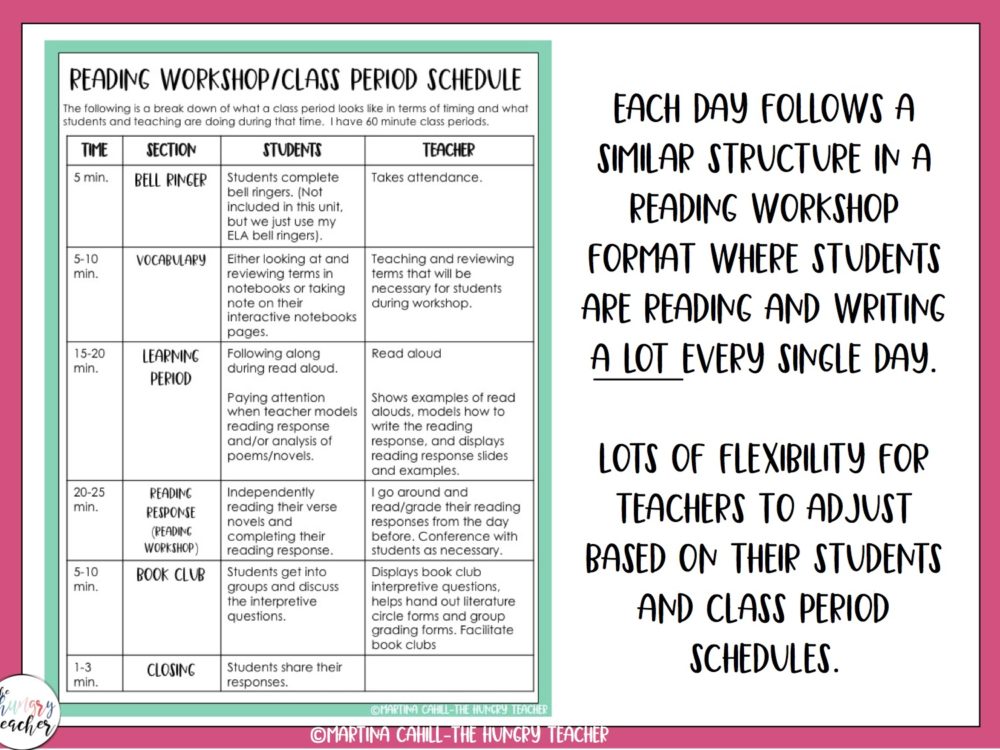
DAILY POETRY/VERSE NOVEL LESSONS
Each day of the lessons follow a very similar format. Everything is outlined for you.
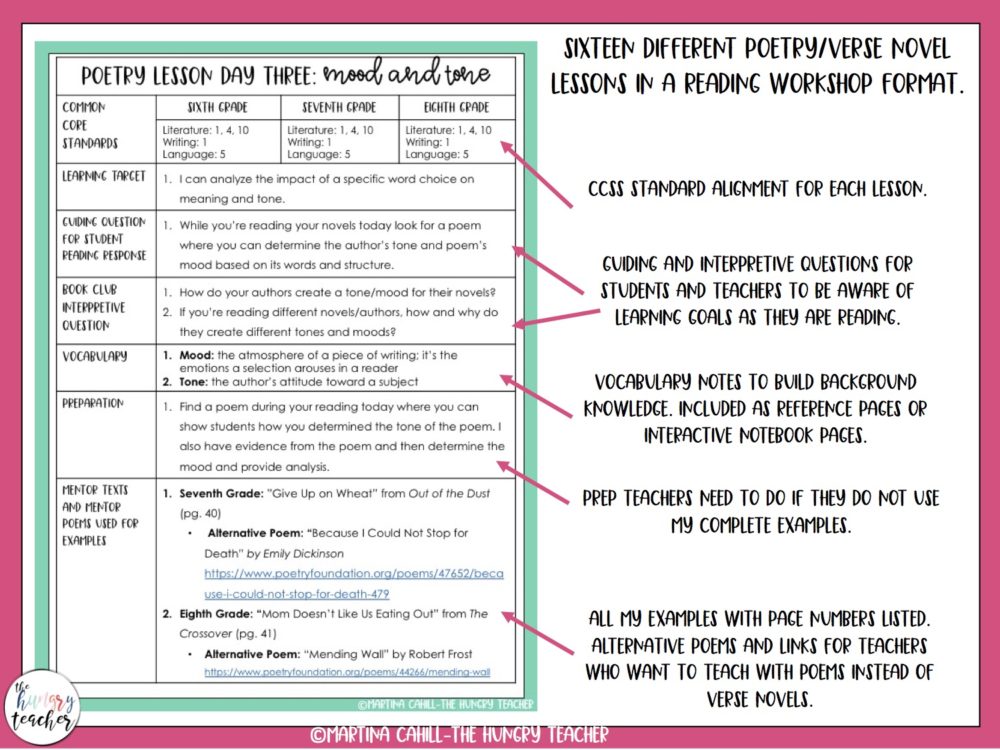
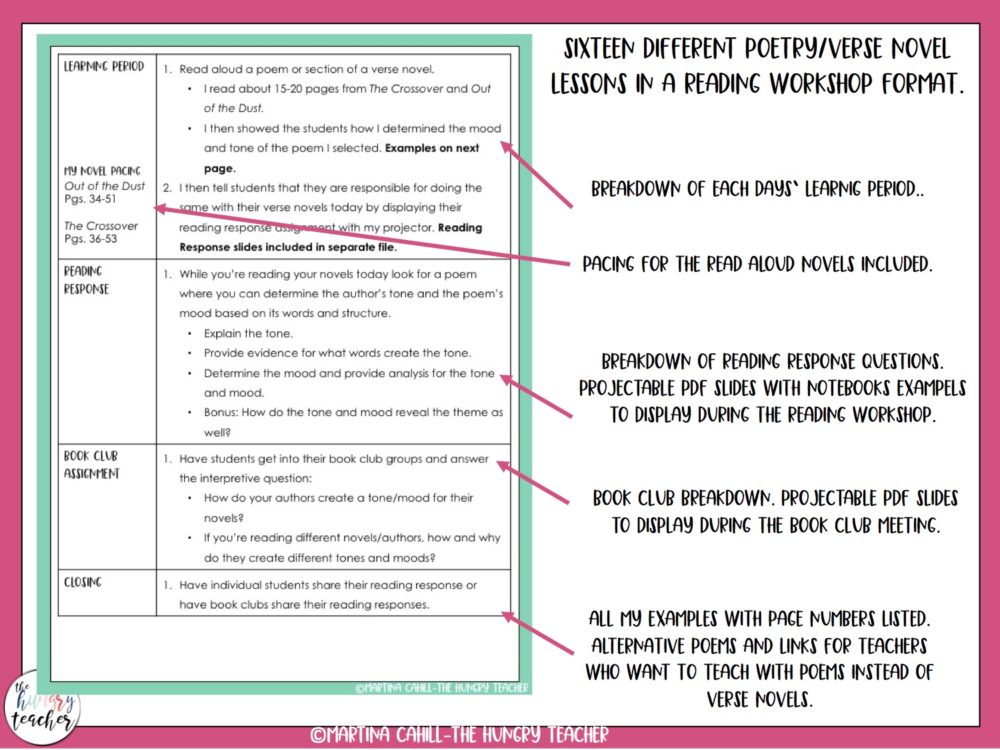
READING RESPONSE EXAMPLES FOR TWO DIFFERENT GRADE LEVELS
I do use Kwame Alexander’s The Crossover as my mentor text with eighth grade and then I use Karen Hesse’s verse novel Out of the Dust with seventh grade.
They aren’t required because I do offer alternative poem options for every lesson. However, it will make your life a million times easier to use them, because all my examples use poems from these two texts. Every single lesson comes with an example of a reading response from both texts.
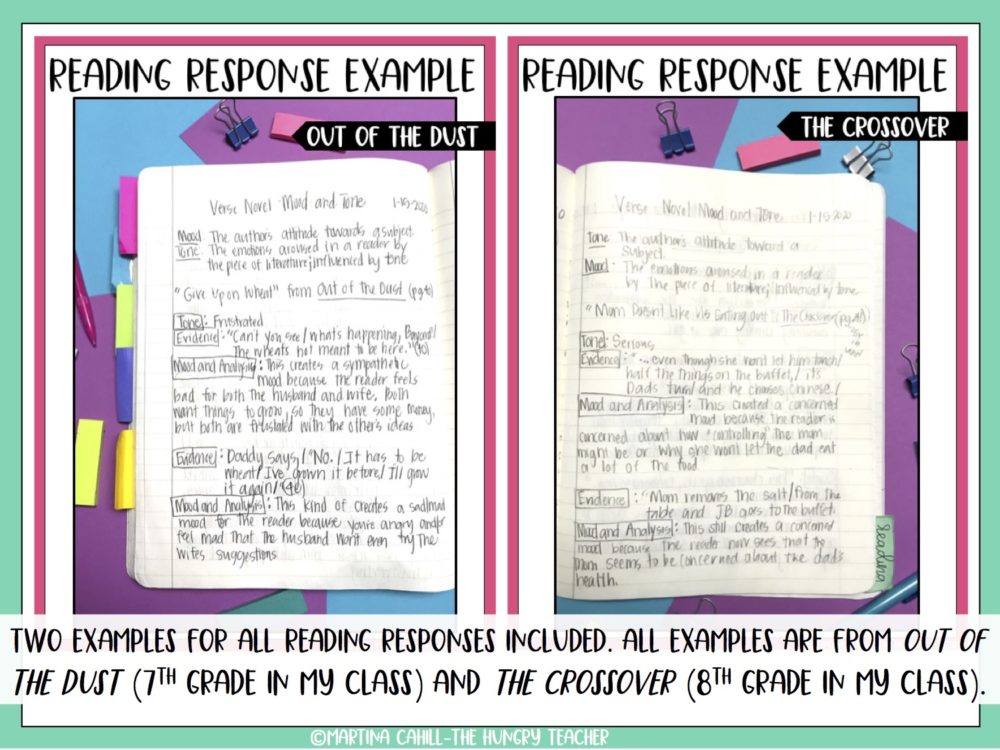
PDF SLIDES TO PROJECT FOR STUDENT REFERENCE DURING WORKSHOP
And as a Middle School English teacher, I know that kids can’t remember what I say ever ha! I made reading response slides with kind of prompts, and then have included an example of a reading response next to it. These are perfect to display during Reading Workshop time. Students can reference the projected slides as their reading and responding to their independent reading verse novel or book club novel.
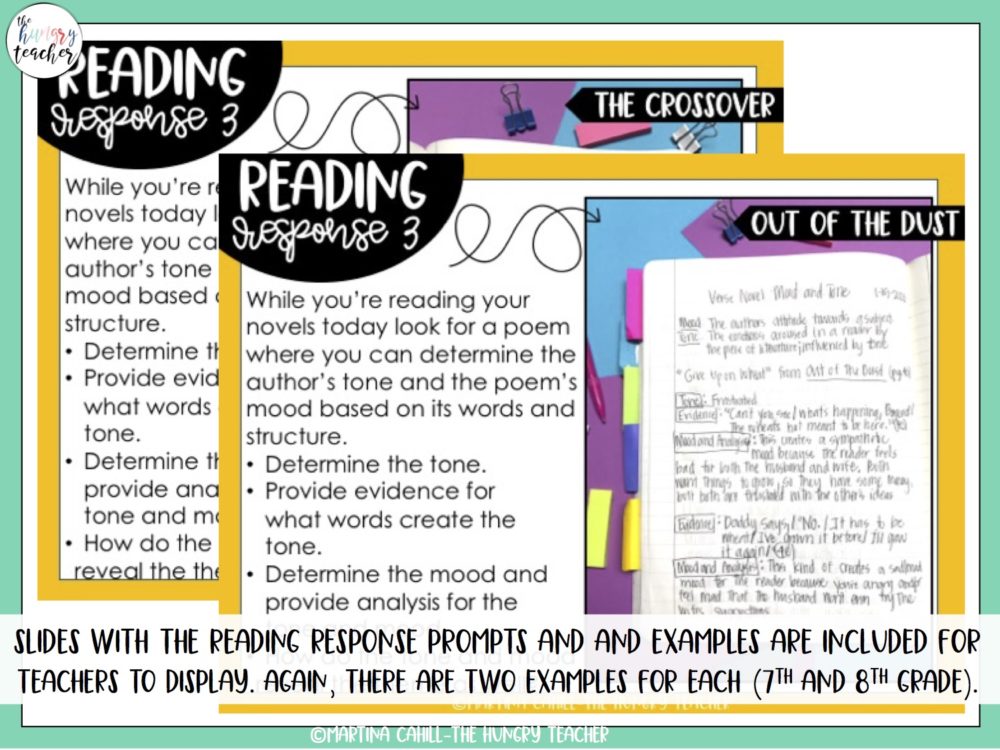
MIDDLE SCHOOL LITERATURE AND POETRY GRAPHIC ORGANIZERS
Again, as a Middle School English teacher, I know that the projected slides with examples will still be a struggle or students who need more structure. Because of that, I included a graphic organizer for each lesson so the organizational piece is done for them. I also created reference sheets as needed. You can get this mood and tone word list as a FREEBIE by clicking here.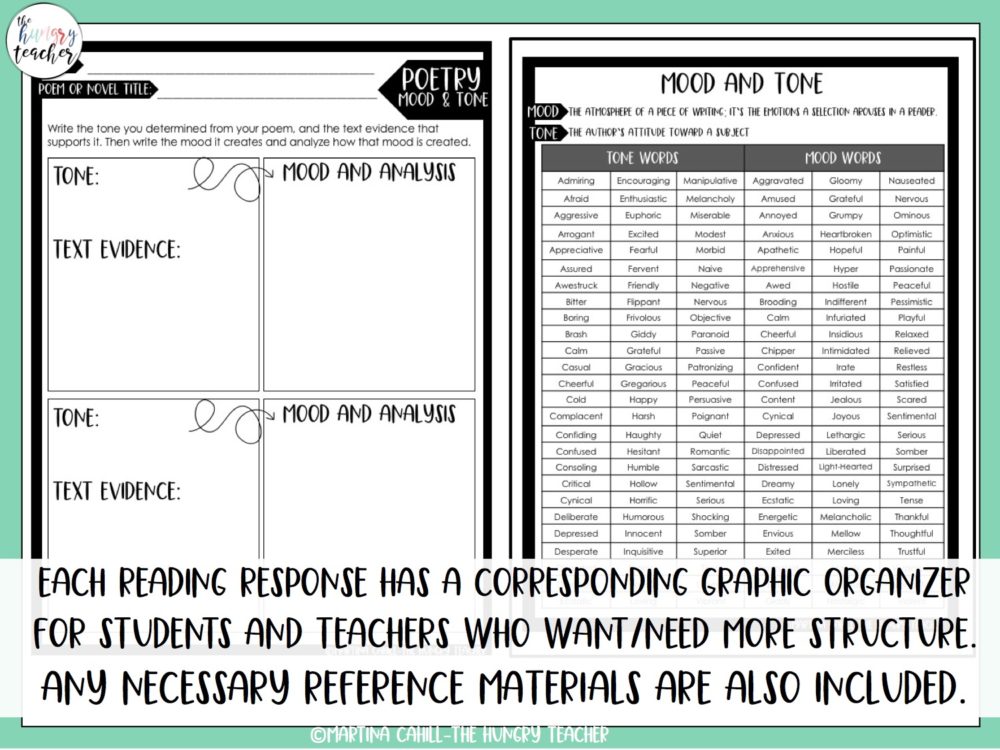
The graphic organizers are included, but they have also been turned into their own resource for teachers who just want the organizers and reading response examples. Click here for just the graphic organizers. 
MIDDLE SCHOOL LITERATURE CIRCLES AND BOOK CLUB RESOURCES
I don’t treat book clubs and literature circles like most. The goal is for kids to be reading and writing about novels, while discussing the novels with classmates. Students naturally ended up meeting with others who read the same novels as them, and having discussions while working on their responses. I did have them break down how much to read so tehy would finish in three weeks, and I also had them get together once a week to discuss.
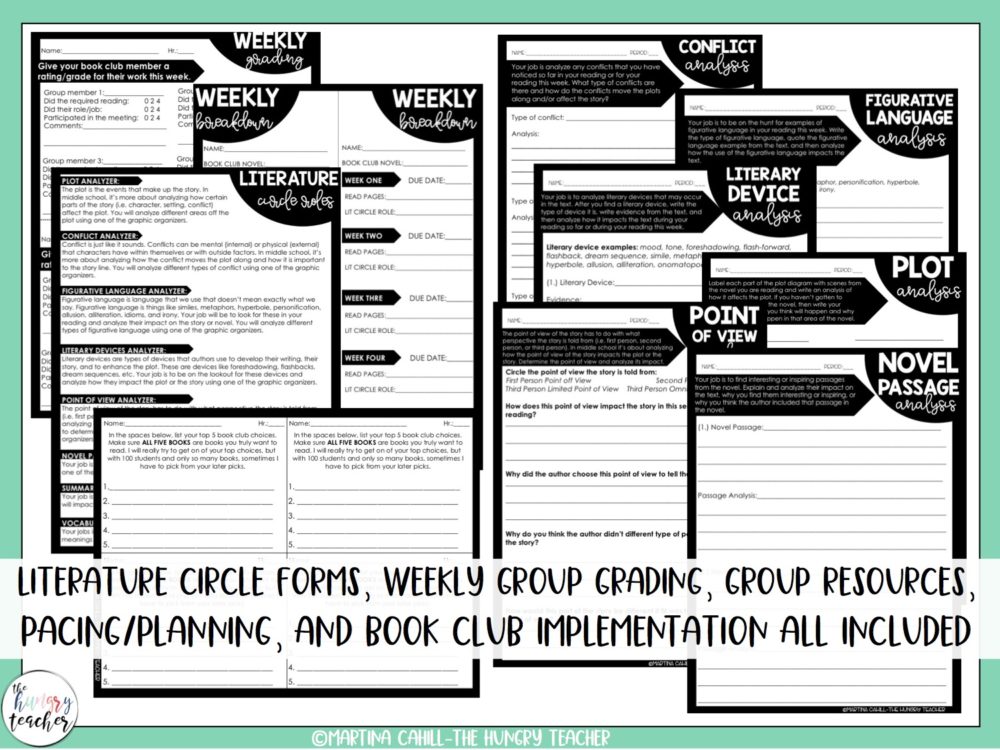
If you want students to meet more and have more discussions then I included Socratic Seminar interpretive question slides to display. These could be displayed during book club meetings for students to have a quick discussion and share their responses.
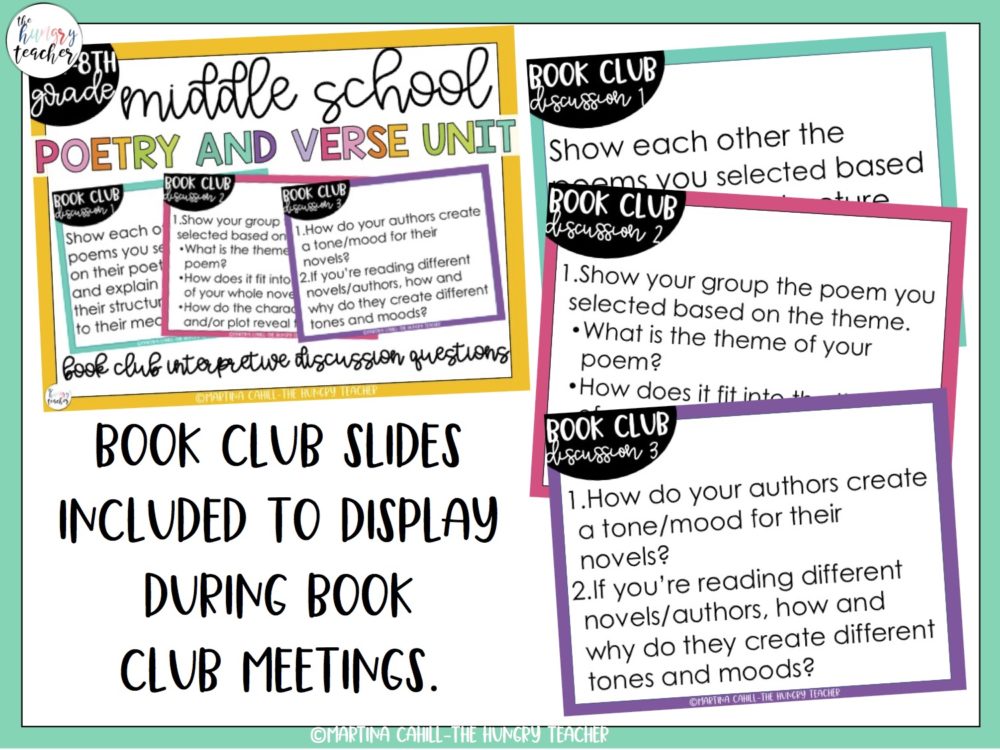
MIDDLE SCHOOL MENTOR SENTENCES TO TEACH GRAMMAR
If you’ve followed me for any length of time during my middle school ELA career then you know how I feel about mentor sentence. These are already included in mentor sentence bundles, but I did take out four sentence from verse novels for teachers to use. These could be used as the bell ringers during your four-week unit. These will be a separate unit, but are included in the poetry resource for you to use.
I have a HUGE blog post all about mentor sentence if you want to know more.
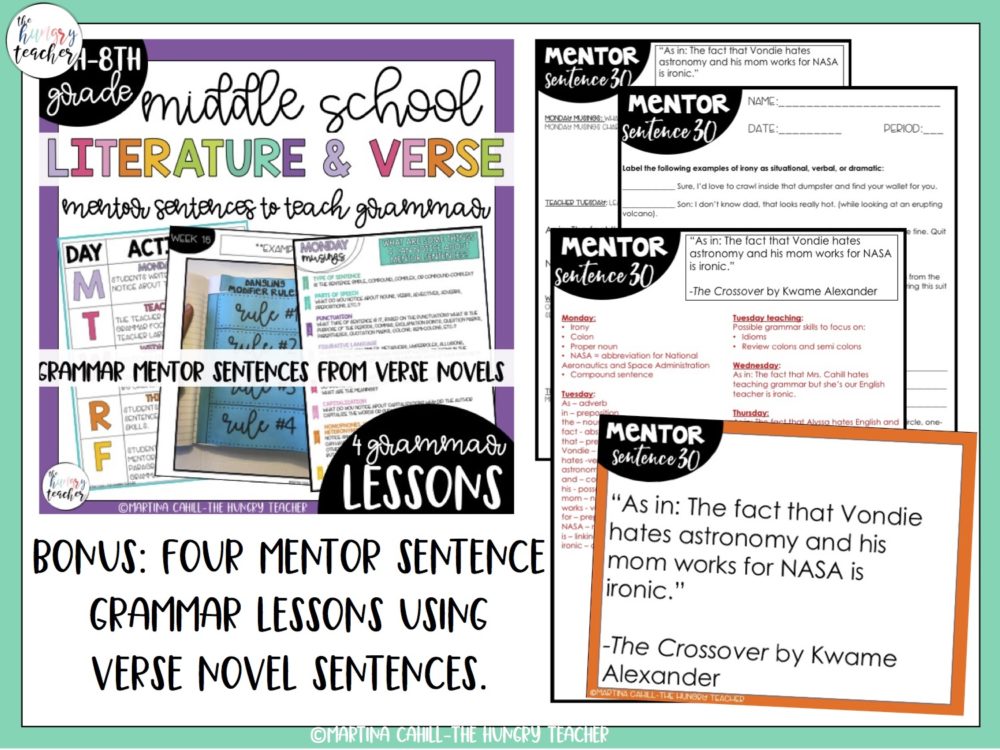
Want a sneak peek at teaching The Hungry Teacher way—with support, structure, and strategy?
When you join the waitlist for The Hungry Teacher’s Hub membership, you get three free classroom-ready resources: a theme unit, an expository writing unit, and a grammar unit introducing mentor sentences. Plus, you’ll get immediate access to a selection of exclusives from the Hub, including editable sub plans, pacing guides, and more.
No strings attached. Just resources you can use right now—and a heads-up when the Hub opens.
3 Free Middle School ELA Units—yours to keep!
JOIN THE WAITLIST + A FREE GIFT
Where to next, line leader?
Welcome to The Hungry Teacher! We create resources that are easy to use, practical, and get results. Teach with confidence—and make it home before dinner.
xo, the hungry teacher
